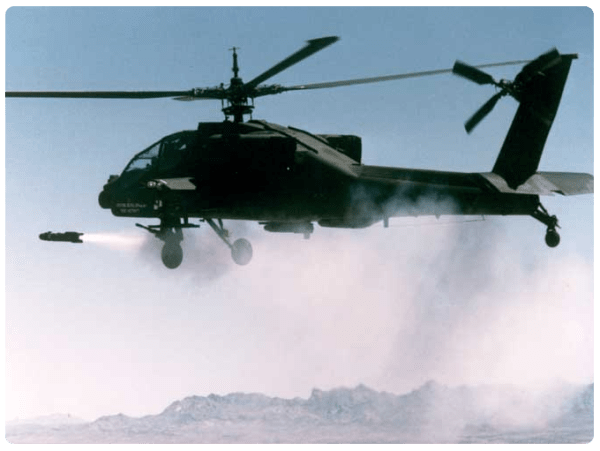US Army AH-64 Apache attack helicopters are refining their ability to detect and destroy enemy aerial drones while forward deployed to the Middle East, a place where the drone threat has exploded in recent months. Apaches have a little-known but proven capability to act in an air defense role against drones. This includes using their Hellfire missiles, which are traditionally air-to-ground weapons, to take them down.
A recent video published on X by US Central Command shows a US Army AH-64 Apache attack helicopter destroying a target drone during “Red Sands” training in the Kingdom of Saudi Arabia.
It makes sense that CENTCOM would be refining an ability to detect, target and destroy drone targets from the air with Apaches, as such a possibility brings clear tactical advantages. In a simple sense, a target must be seen in order to be destroyed, and an Apache in the air must be positioned with an improved target envelope with which to identify otherwise difficult-to-detain beyond-line-of-sight targets.
The CENTCOM video shows the Apache attacking drones was indeed an AH-64 Longbow variant, a radar which has received several software upgrades from Lockheed designed to better enable single-track targeting, longer detection range and 360-degree surveillance. Not only does the AH-64 Longbow radar operate with an increasingly sensitive and long-range detection capability, but Apache sensors are increasingly able to “network” with both ground control targeting systems and aerial nodes such as other helicopters and drones in position to “see” and “track” an attacking drone from beyond the horizon. An ability for Apache attack helicopters to destroy drones from the air is likely increasingly possible due to newer methods of multi-domain target data sharing. Perhaps an enemy drone can be seen by a ground command and control station, satellite, fighter jet or nearby drone, all technologies in position to transmit target specifics to an Apache.
Using Apaches in this secondary role could prove capacity is certainly lesser known, yet it is something likely to prove extremely impactful in the event of a wider conflict war in the Middle East given the ubiquitous proliferation of weaponized drones in the region. As is often the case with newer uses of advanced technology, forces acquiring new attack drone technologies implement adjusted Concepts of Operation.
US Army AH-64 Apache attack helicopters are refining their ability to detect and destroy enemy aerial drones while forward deployed to the Middle East, a place where the drone threat has exploded in recent months. Apaches have a little-known but proven capability to act in an air defense role against drones. This includes using their Hellfire missiles, which are traditionally air-to-ground weapons, to take them down.
A recent video published on X by US Central Command shows a US Army AH-64 Apache attack helicopter destroying a target drone during “Red Sands” training in the Kingdom of Saudi Arabia.
It makes sense that CENTCOM would be refining an ability to detect, target and destroy drone targets from the air with Apaches, as such a possibility brings clear tactical advantages. In a simple sense, a target must be seen in order to be destroyed, and an Apache in the air must be positioned with an improved target envelope with which to identify otherwise difficult-to-detain beyond-line-of-sight targets.
The CENTCOM video shows the Apache attacking drones was indeed an AH-64 Longbow variant, a radar which has received several software upgrades from Lockheed designed to better enable single-track targeting, longer detection range and 360-degree surveillance. Not only does the AH-64 Longbow radar operate with an increasingly sensitive and long-range detection capability, but Apache sensors are increasingly able to “network” with both ground control targeting systems and aerial nodes such as other helicopters and drones in position to “see” and “track” an attacking drone from beyond the horizon. An ability for Apache attack helicopters to destroy drones from the air is likely increasingly possible due to newer methods of multi-domain target data sharing. Perhaps an enemy drone can be seen by a ground command and control station, satellite, fighter jet or nearby drone, all technologies in position to transmit target specifics to an Apache.
Using Apaches in this secondary role could prove capacity is certainly lesser known, yet it is something likely to prove extremely impactful in the event of a wider conflict war in the Middle East given the ubiquitous proliferation of weaponized drones in the region. As is often the case with newer uses of advanced technology, forces acquiring new attack drone technologies implement adjusted Concepts of Operation.
Certainly, a modern warfare environment, such as that in the Middle East, continues to indicate a growing and increasingly serious drone threat. This has become the case in large measure because commercial drone technologies have not only become widespread and easily available but also more increasingly weaponized. These technical and tactical developments have been on display in Ukraine as well, where surveillance and kamikaze “strike” drones continue to heavily impact warfare developments.
Lockheed data further specifies that Version 6 FCR software upgrades to the Longbow radar system include single target track, 360-degree surveillance mode as well as extended detection range capability, all factors impacting the attack helicopter’s ability to find and destroy drones from the air. Furthermore, millimeter wave technology is “all-weather,” meaning it can “see” through cloud, smoke, rain and other weather obscurants.
Added to these variables, the upgraded AH-64 “E” model operates with a millimeter wave fire control and, as outlined in FAS.org, a radar frequency interferometer. The Apache’s LONGBOW Fire-Control-Radar system, used in Operation Iraqi Freedom and Operation Enduring Freedom, provides the helicopters with automatic target detection, classification and attack possibilities in a wide-range of terrain and weather conditions.
Hellfire missiles have historically been used as air-to-ground“tank-killing” weapons. However, upgrades to the weapon have been underway for many years. In addition to its anti-armor capabilities, Hellfires were used extensively in an anti-personnel capacity in Iraq and Afghanistan against light vehicles, pick-up trucks and groups of individual dismounted fighters, so it would make sense that the weapons have been adapted for air-to-air attacks as well. It is also possible that the Army’s newest variant of a Hellfire, the Joint-Air-Ground-Missile (JAGM) may also be used to destroy drones. The JAGM, in development for many years as a replacement for legacy Hellfires, is engineered with what’s called a “tri-mode” seeker, meaning it can destroy targets using RF guidance, Semi-Active Laser technology or all-weather “millimeter” wave technology. JAGM reached Initial Operational Capability with the Marines in 2022.
Although unlikely, it is also possible that the US Apaches are firing the JAGM. In development for years as a future HELLFIRE-kind of helicopter launched variant, the upgraded JAGM has only recently been entering the force as a weapon in full production. The U.S. Marine Corps declared Initial Operating Capability (IOC) for the AGM-179A Joint Air-to-Ground Missile (JAGM) on the AH-1Z Viper, March 1, 2022.
A signature element of the JAGM is its “multi-mode” seeker which utilizes RF Frequency targeting, semi-active laser targeting and millimeter wave technology. This not only increases a potential target envelope but also allows for successful precision targeting in a wider sphere of tactical scenarios. Lockheed data describes the “JAGM-MR” as a “tri-mode seeker employs a near-infrared (NIR)sensor, which is a third sensor incorporated into the guidance system compared to JAGM, which utilizes a dual-mode sensor system.”
Advanced variants of the Hellfire and the emerging JAGM both operate an advanced targeting technology built into the AH-64 E model called Gen 3 TADS/PNVS electro-optical targeting system. The increased target image fidelity, range and resolution of this targeting system likely greatly improves an Apache’s ability to identify and destroy enemy drones with greater precision at longer stand-off ranges.
In recent years, tank-killing Hellfire missiles have increasingly been used for of anti-personnel attacks as well during the years of counterterrorism campaigns in Iraq and Afghanistan. These were at times enabled by the addition of a “metal” sleeve placed around the Hellfire projectile for the purpose of increasing fragmentation and the lethality of the weapon. It would make sense that a “fragmenting” variant of a Hellfire missile would be used to counter moving drones, drone groups and even some drone swarms given its ability to disperse fragmenting projectiles.
While the Central Command video shows a strike on a single drone, it would make sense if Apache crews were also developing methods of attacking and destroying drone swarm threats. Groups of large numbers of mini-drone sensors or explosives are also increasingly available and easier to use by potential enemies, so it would make sense if Central Command were also preparing to counter drone swarm threats. Drone swarms, by design, are often intended to blanket an area with surveillance, overwhelm defenses with sheer numbers and conduct “area” attacks across larger or more dispersed targets.
Therefore, another “next-step” for Apache counter-drone tactics could involve the use of “proximity” fuses to destroy or disable drone swarms by detonating in a specific threat “area” to disperse projectiles and fragmentation sufficient to destroy multiple drone targets. Proximity fuses are explosives which are sent to a designated or specific “spot” in a target area to detonate and disperse projectiles against a group of targets.
Added to this, there is the possible use of munitions with a “proximity” fuse able to reach a designated target “area” and detonate a fragmented “blast.” This improves an ability to destroy moving enemy drones and potentially destroy or disable several drones operating in close proximity with one another. Typically proximity fuses are developed for ground-attack from land-based vehicles, as years ago the Army and Northrop armaments tested a “proximity” fuse against representative enemy targets with a 30mm chain gun in Kingman Arizona at the Bushmaster Users Conference.
“Proximity” fuses are also possible on round fired by an AH-64 Apache’s upgraded M230LF Chain Gun, a weapon modified in recent years with increased capability against lightly-armed moving ground vehicles. Given that it is a Chain Gun, which draws power from an external source to fire an “ammo” belt placing multiple rounds on target, it seems realistic that a proximity fuse could potentially be configured to destroy drones and groups-of-drones from the air.
Improved Target Networking
An ability for helicopters to track and destroy drones from the air is also likely supported and further improved through the use of networking and targeting breakthroughs. For instance, AI-enabled methods of aggregating, organizing, analyzing and transmitting critical target information at the point of collection using both manned and unmanned systems allows for much faster target identification and verification. In a tactical sense, this means that one air-or-ground “node” in position to detect a drone threat would be increasingly capable of verifying an enemy drone target using advanced algorithms to bounce incoming sensor data against a vast database to determine targets specifics, find relevant information within a large volume of incoming sensor and ISR data and transmit specific, time-sensitive information to potential “attack” locations such as Apache helicopters in position to destroy the enemy drones.
This kind of drone attack could be interpreted as a “next-step” within a longstanding US Army modernization trajectory which goes back many years. US Army Apache helicopters have been able to control the flight path and sensor payload of a wingman drone from the cockpit of the helicopter for many years now, a process in place for years in Afghanistan and Iraq known as manned-unmanned teaming (MUM-T). Using MUM-T as it is called,
One of the important elements of the many successful US Navy intercepts of Houthi attack drones of course included deck-launched interceptor weapons fired from Vertical Launch Systems, yet of equal or even greater significance, many of the Houthi drones were shot down in the air by carrier-launched F/A-18s. In a similar fashion, U.S. Apaches now appear to be further honing an ability to track and destroy moving targets in the air.
Apache pilots have for years been able to network with targeting drones to identify enemy targets from the ground prior to take off. Given this ability to operate drones from the cockpit, it also seems conceivable that, moving forward, Apaches could direct armed drones to track and destroy enemy drones as part of an air-to-air drone strike.



